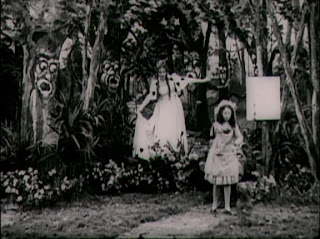The Wonderful Wizard of Oz (1910)
"The Wonderful Wizard of Oz" is the earliest surviving film adaptation of the L. Frank Baum series. At only 13 minutes long, it is a severely abridged version of Dorothy's journey through Oz. It is overshadowed by its successors, notably "The Wizard of Oz" (1925) and "The Wizard of Oz" (1939), but still offers an interesting and unique look into the world of film.
Made in 1910, "The Wonderful Wizard of Oz" was produced by the Selig Polyscope Company. Selig Polyscope was established by William Selig in 1896 in Chicago. Selig Polyscope is noted for being the first company to have a permanent studio in L.A. Although Selig produced the first films of many future stars, like Harold Lloyd, Fatty Arbuckle and Colleen Moore, it ended production in 1918.
 |
| Hand-tinted production still from "The Fairylogue and Radio-Plays" |
William Selig had helped produce "The Fairylogue and Radio-Plays," an early adaptation of Baum's work. The show was canned after only a few months and the "The Wonderful Wizard of Oz" was created to fulfill a contractual obligation and made without direct input from Baum. Although it was believed to have been based on "The Fairylogue and Radio-Plays," it appears to be a combination of the original material, which the company took liberty with, and material from the 1902 musical. In the end, this gives us an odd combination of storylines.
 |
| Dorothy with the Tin Man |
The cast remains unknown. It is said that a young Bebe Daniels starred as Dorothy, and that it was written and directed by Otis Turner. Due to Selig's relatively short lifespan, and the lack of documentation surrounding it -- especially in comparison to other studios like American Biograph -- it is difficult to confirm their involvement. What we do know is that the character design/makeup is similar to that used in the 1902 musical version, as well as that used for "Fairylogue."
 |
| The gang finds the Tin Man |
Dorothy -- along with Toto, and an unnamed cow and donkey -- discover Scarecrow. Dorothy helps him down from his post and the group travels along together when the cyclone hits. The Scarerow helps Dorothy and the animals take cover in a haystack, when the entire stack is lifted and blown into the land of Oz.
Once they land in Oz, we are taken to the castle where the wicked witch Momba has taken over. Upon returning to Dorothy and company, we see the Cowardly Lion stalking Dorothy. This prompts Glinda the Good Witch to appear and turn Toto into a lion-sized canine, capable of fighting off any predators. Once the group discovers that the Cowardly Lion is, in fact, kind and gentle, they continue on through the forest, happening upon the Tin Man.
Dorothy restores the Tin Man and the group does an inspired dance number celebrating their new friendships. As they journey deeper into the forest, arm-in-arm, they come across Momba's house. Momba quickly captures them and locks them up, but they are freed once Dorothy learns that witches melt when exposed to water.
 |
| The Wizard of Oz flies away |
The witch defeated, the group is able to see off the Wizard of Oz as he flies off in his hot-air balloon, and the Scarecrow is crowned king.
The Result
Though primitive (especially compared to French films being made at the same time -- particularly those of Max Linder and Georges Melies), the film has some fine points to it. The cyclone which carries the cast to the land of Oz is gimmicky, but entertaining. The swirling mass of hay draws laughs now when, perhaps, it should be drawing gasps, but the attempt is still admirable.
The set design for the castle is reminiscent of Melies. The background is incredibly detailed, making it appear as though it is three-dimensional. This is also true of the forest sets where we find the Tin Man and Momba. Momba's disintegration after being splashed with water is also impressive and edited quite well. Selig, like Melies, was a magician and no doubt understood the concept of stage spectacle and transferring it from the stage to the screen.
 |
| Momba descends on Dorothy and her friends |
It is (deservedly) overshadowed by its successors, but "The Wonderful Wizard of Oz" is worth the watch, if only to give the viewer a new-found appreciation for that which followed.
Watch the entire film for yourself below.






Absolutely charming. Great job, Janelle!!
ReplyDelete